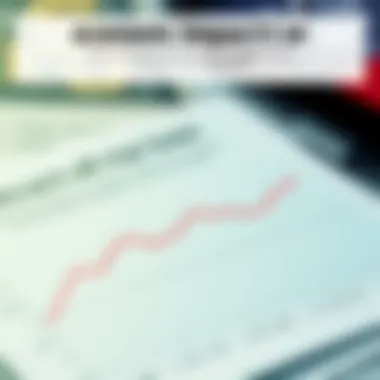Analyzing the Scale of the US National Debt: Insights


Intro
The conversation surrounding the U.S. national debt has become more essential in recent years. As the debt continues to climb, many people find themselves struggling to understand its implications. The national debt isn't just numbers stacking up on a balance sheet; it impacts the daily lives of citizens, the functionalities of government, and the overall economy. From students embarking on their financial journeys to seasoned investors analyzing market trends, grasping the concept of national debt can arm individuals with the knowledge necessary for informed decisions.
This article will explore the magnitude of the U.S. national debt from various angles. We'll look at its historical context, delve into the factors that contribute to its growth, and discuss the economic ramifications that stem from prolonged debt levels. By breaking down these components, we can better comprehend how such debt shapes our current landscape and what it might mean for the future. Let's dive deeper into key financial terms and concepts that will be pivotal in our journey through the intricacies of national debt.
Investment Dictionaries
Understanding the U.S. national debt heavily relies on familiarizing oneself with certain financial jargon. Clear definitions can pave the way for deeper insight into the mechanisms at play.
Key Financial Terms
- National Debt: This refers to the total amount of money that a country's government has borrowed. In essence, it’s the sum of all past budget deficits, minus any surpluses. This debt is accumulated over time and is often expressed in trillions of dollars, highlighting the sheer scale of borrowing.
- Deficit: A deficit occurs when government expenditures exceed its revenues in a given fiscal year. As the government spends more than it takes in, debt accumulation is often necessary to cover the gap.
- Interest Rates: The percentage paid on borrowed money. In the context of national debt, rates can impact the total amount repaid over time, thus influencing economic conditions.
- Gross Domestic Product (GDP): This is a measurement of all goods and services produced in a nation. The ratio of national debt to GDP can provide insights into a country's ability to manage its debt load without resorting to drastic measures.
Investment Strategies Explained
When scrutinizing the national debt, it’s crucial to apply strategic thinking similar to investment approaches. Here are some considerations:
- Risk Assessment: Understanding the implications of rising national debt involves evaluating potential risks associated with its growth, including inflation or interest hikes.
- Long-term Perspective: Unlike day-to-day investments that might yield quick returns, national debt requires a long-term view. Analyzing how debt trajectories can influence future fiscal policies is critical.
- Diversification of Assets: Just as one diversifies investments to mitigate risk, understanding the composition of national debt—such as who holds it, be it foreign nations or domestic entities—is important for grasping the national financial health.
Educating oneself on these terms not only equips readers with a better grasp of economic discussions but also sets the stage for understanding the broader implications of debt on personal finance and policy.
“The national debt is like an iceberg; one-third is visible above the ocean surface, while two-thirds are hidden, threatening the stability beneath.”
As we transition into analyzing the scale itself, we will dive deeper into both present and historical contexts, ensuring a robust understanding of how we arrived at our current debt situation.
Understanding National Debt
Understanding national debt is crucial for anyone looking to grasp the nuances of economics and public finance. It shapes the economic landscape of a nation and influences policy decisions at multiple levels. When one dives into national debt, it’s like opening a Pandora's box filled with financial implications, historical layers, and complex relationships. This exploration is essential for students, investors, advisors, managers, and analysts alike, who all have a vested interest in how debt impacts economic growth, government functionality, and individual financial decisions.
In this article, we’ll dissect what national debt truly signifies, categorizing its forms and exploring the broader repercussions of its growth. Understanding these elements not only aids comprehension, but also equips individuals with the tools necessary to navigate financial discussions and forecasts. Moreover, it sheds light on the potential risks associated with rising debt levels and helps in evaluating future economic scenarios. Here’s what’s on the agenda:
- Definition of National Debt: We'll set the stage by defining the very term that fuels our discussions.
- Types of National Debt: We will distinguish between Public Debt and Intragovernmental Debt, laying bare their unique characteristics and roles.
This foundational knowledge will provide context as we venture into current figures, historical perspectives, implications, and future projections concerning the national debt.
Current Status of US National Debt
The current status of the US national debt is a pivotal component of comprehending its broader implications on the economy and public policy. As the figures continue to grow, understanding the context and ramifications becomes increasingly essential. For students, investors, and policymakers alike, grasping the nuances of the national debt not only aids in informed discussions but also shapes financial strategies and governmental decisions. In light of recent events, taking stock of the national debt reveals pressures that influence both economic stability and policy formation.
Latest Figures and Statistics
Debt Ceiling Context
The debt ceiling represents a significant mechanism limiting the total amount of money the federal government can borrow. This framework impacts the current status of the national debt significantly. One key characteristic of the debt ceiling is that it serves as a political tool, often leading to contentious debates in Congress about fiscal responsibility. Recent debates around the increase in the debt ceiling reflect the ongoing struggle to balance necessary funding with budgetary constraints. This focus on managing the debt ceiling has important implications for future borrowing and fiscal strategies.
A unique feature of the debt ceiling is its cyclical nature; it often becomes a point of contention, leading to risk of government shutdowns or defaults. This creates uncertainty in markets and pushes interest rates upward - a disadvantage for borrowers and investors alike. Managing the debt ceiling effectively can present challenges but is essential to maintaining the credibility of US fiscal policy.
Debt per Capita
Debt per capita is a potent figure reflecting the collective burden of national debt on every individual in the US. It’s a straightforward metric that highlights personal stakes within the broader economic landscape. Using this figure, citizens can better understand how much public debt translates into individual responsibility.
The critical aspect of tracking debt per capita is its ability to illustrate disparities in wealth distribution and economic burden. It often shows troubling trends when linked with economic growth or recession periods. Notably, a rising debt per capita begs the question of sustainability within public spending and fiscal strategies.
A significant advantage of utilizing this metric is that it simplifies complex data into digestible insights, making it a popular choice in discussions around national debt. However, it is also crucial to consider that high debt levels can create skepticism regarding the government’s economic policies, potentially leading to reduced consumer confidence.
Factors Influencing Current Levels
Economic Policies
Economic policies serve as pivotal drivers of the national debt. They encompass a range of decisions from taxation, spending programs, to regulation, all of which can influence how much money the government requires. A notable characteristic of these policies is their direct impact on both growth and deficits. Favorable economic policies can stimulate growth, potentially enhancing revenue and curbing deficits.


The uniqueness of economic policies lies in their adaptability; they can be refined to respond to changing economic conditions. However, poorly designed policies can lead to spiraling debt levels, putting stress on the economy. Thus, understanding these influences is crucial for anyone focusing on the implications of the national debt.
Socio-Political Influences
Socio-political influences shape the landscape of national debt indirectly through public sentiment and legislative action. Factors such as public opinion on government spending, bipartisan cooperation, and pressure from interest groups all come into play. A key characteristic here is that these influences can drive the urgency or reluctance to address rising debt levels.
The interaction between social attitudes and political maneuvering can significantly impact decisions made about budgeting and spending. A unique feature of socio-political influences is their potential to either delay needed reform or usher it in through grassroots movements or lobbying. Understanding these dynamics is essential for investors and policymakers who seek to navigate the complexities of the national debt and its socio-economic repercussions.
"The national debt is not just numbers on a balance sheet; it reflects the choices of society and how we prioritize our resources."
Accessible and insightful data around the current status of US national debt illuminates how dynamic and multifaceted these issues are. As the landscape shifts, comprehending these statistics and influences is more than just academic; it’s pivotal to informed decision-making for all stakeholders.
Historical Perspectives on US Debt
Understanding the historical context of US national debt is crucial in capturing its evolution and the influences that shaped its current landscape. This section serves to highlight the significant eras and milestones that impacted fiscal policies, allowing readers to appreciate the nuances and complexities surrounding the national debt. Historical perspectives not only provide key insights into how governmental decisions cascade down to the financial well-being of citizens but also offer a broader understanding of economic cycles, thus informing present-day discourse about management strategies and future forecasting.
Trends Over the Decades
Examining the trends in national debt over the past several decades reveals a pattern of substantial fluctuations often linked to broader economic conditions. For instance, post-World War II marked a significant decrease in debt relative to GDP, primarily due to aggressive tax measures and economic growth. However, the economic landscape evolved, and by the late 20th century, the debt saw a sharp rise once again, influenced by tax cuts, increased social spending, and the expansive nature of the federal government.
The turn of the century brought the national debt into sharp focus, especially during times of crisis. Notably, events such as the 2008 financial crisis highlighted the fragile state of economic stability, where debt levels soared as the government implemented bailouts and stimulus measures to stabilize the economy. This section will underscore how each decade carries its fingerprints on national debt, reflecting policy decisions, economic challenges, and societal needs.
Significant Events Leading to Debt Changes
The Great Depression
The Great Depression is marked by its profound economic turmoil, triggering a shift in governmental roles and responsibilities that fundamentally altered national spending patterns. During this era, which spanned the late 1920s through the 1930s, the high unemployment rates and collapsing financial markets led the U.S. government to increase its expenditure dramatically. The New Deal programs initiated by President Franklin D. Roosevelt introduced a variety of social and economic reform measures aimed to stimulate recovery.
This period underscores the precarious balance of attempting to revive an ailing economy while accumulating debt. The key characteristic of the Great Depression is its role as a catalyst for the modern welfare state, allowing the government to monitor and influence the economy actively. A unique feature of the Great Depression is that it set a precedent for future interventions in economic downturns, highlighting both advantages, like improved safety nets, and disadvantages, such as increased reliance on government financing.
World War
World War II is another pivotal moment in debt accumulation. The financing of the war effort necessitated enormous expenditures, far surpassing previous levels. As the nation rallied its resources, the U.S. experienced rapid industrial growth, which brought about economic changes in household spending and production outputs. Governments initiated war bonds and raised taxes, enabling the country to manage its debt more effectively than during earlier conflicts.
A notable characteristic of this period is the united public investment in war bonds, fostering a sense of collective responsibility. The unique feature of World War II lies in its transformation of the American economy, pushing it from an isolationist stance into a global power, while also accruing significant debt. This event marks a turning point, propelling the U.S. into a post-war era marked by economic prosperity but also by the lingering effects of heightened debt levels.
Financial Crisis
The 2008 financial crisis offers yet another lens through which the evolution of the US national debt can be scrutinized. Triggered by a collapse in the housing market, this crisis severely impacted financial institutions, prompting an urgent response from the federal government through TARP (Troubled Asset Relief Program) and quantitative easing measures. The key characteristic of this crisis was the sheer scale of the intervention required to stabilize the financial system, resulting in an increased deficit and skyrocketing public debt.
The unique feature of the 2008 financial crisis is the multifaceted response that combined fiscal stimulus with monetary policy adjustments. This dual approach set the stage for debates around the sustainability of such high debt levels and potential long-term implications for inflation and economic stability. The lessons learned during this time encapsulate critical considerations as policymakers grappled with the balance between necessary intervention and prudent fiscal management.
The historical context provides a richer understanding of national debt, illustrating the cyclical nature of economies and the impact of significant events on fiscal policy.
Implications of Rising Debt Levels
The implications of rising debt levels are far-reaching and multifaceted. Understanding these implications is critical to navigating the complex landscape of national finance. As individuals and institutions grapple with the reality that the national debt is climbing higher, it becomes essential to examine not only the immediate effects but also the longer-term ramifications that this growing debt may bring. In this section, we will delve into three major consequences, namely how debt interacts with economic growth, its impact on inflation and interest rates, and how it affects government spending and budget allocation.
Economic Growth and Debt
Economic growth and national debt have a symbiotic relationship. When the government borrows money to invest in infrastructure, education, or healthcare, it can spur economic growth in the short term. However, excessive borrowing can backfire and stifle growth over time.
For instance, if the government takes on too much debt, it may have to raise taxes or cut public services to meet its obligations later on. This can create a cycle where high debt constrains future growth, leading to an environment where innovation and investment are stifled. If businesses and consumers sense a government grappling with overwhelming debt, they may hold back on spending and investment, contributing to a sluggish economic environment.
The challenge lies in finding the right balance. When borrowing is strategically directed toward productive investments, the potential for a prosperous economy increases. Conversely, if debt accumulates without corresponding economic return, the prospects of sustainable growth dim.
Impact on Inflation and Interest Rates
Rising national debt can also lead to unnerving trends in inflation and interest rates. When governments increase borrowing significantly, this can lead to higher demand for loanable funds. In turn, this drives up interest rates, making it more costly for businesses and individuals to borrow. As borrowing costs rise, spending tends to decrease, potentially cooling down the economy.
Moreover, if inflation expectations rise in response to heightened debt levels, it can create a vicious cycle. Higher inflation means that purchasing power erodes, which may compel the Federal Reserve to increase interest rates further to combat inflation. This, in turn, can stifle economic growth, creating a precarious situation for policy makers trying to manage the fine balance of growth and stability.


"Increased national debt is like a double-edged sword; it can either sharpen a nation’s economic edge or create a dull impact on its fiscal future."
Government Spending and Budget Allocation
The issue of national debt has a profound influence on government spending and budget allocation. When debt levels rise, policymakers often face difficult choices about how to allocate scarce resources. Increased interest payments on existing debt can consume a significant portion of the budget, squeezing funding for essential public services such as education or healthcare.
Consider how budget allocation looks in this scenario:
- Increased interest payments absorb funds that could otherwise be invested in social programs.
- Prioritization shifts toward servicing debt rather than towards growth-oriented expenditures.
- Future generations may bear the consequences of today’s borrowing, as reduced government services become the norm.
As a considerable portion of the budget goes toward paying interest on the national debt, achieving equilibrium in fiscal policy becomes a Herculean task. To ensure the future economic health of the country, strategic planning and prioritization in spending become paramount.
Future Projections of National Debt
Understanding the future trajectory of the US national debt is critical in this current economic climate. It's much more than just numbers on a page; the projections reveal the potential implications for government policy, economic stability, and individual financial planning. Grasping where we’re headed allows investors, policymakers, and citizens alike to strategize and adapt. This section delves into how we can forecast national debt and the possible economy scenarios that could unfold from such projections.
Debt Forecasting Models
Debt forecasting models serve as tools to predict how the national debt will evolve over time. They incorporate various economic indicators such as GDP growth, interest rates, and fiscal policy decisions. One prominent model used often is the Congressional Budget Office (CBO) model, which projects debt based on varying assumptions about the economy. This approach looks at historical patterns and combines them with current data to create scenarios that might play out over the coming years.
The strength of these models lies in their ability to simulate different pathways. For instance, if the government increases spending on infrastructure, projections might show a short-term rise in debt, offset by long-term growth in GDP, as the economy potentially grows stronger from these investments.
On the flip side, models also consider the impact of austerity measures. Reductions in government spending could stabilize debt levels but may also hinder economic growth.
Potential Economic Scenarios
Continued Growth
When considering continued growth, this implies an ongoing, robust economic situation where GDP expands, unemployment drops, and government revenues increase. Such a scenario tends to paint a bright picture. It allows for higher tax receipts that can minimize forecasted hikes in national debt.
A key characteristic of this outlook is the expectation of sustainable investment in innovation and workforce development. This encourages a virtuous cycle where businesses thrive, generating more job opportunities and tax income for the government.
Moreover, the continued growth scenario highlights the potential for structural reforms aimed at enhancing productivity across various sectors. These reforms might entail adopting new technologies or streamlining regulations, thus directly boosting economic output and reducing debt as a percentage of GDP.
However, the risk here is complacency. With optimism, policymakers may ignore the warning signs of excessive borrowing or inadequate fiscal discipline, which could lead to vulnerabilities in the future.
Recession Implications
On the other hand, recession implications delve into a less rosy picture. A downturn affects all sectors of the economy, leading to diminished tax revenues and, consequently, higher debt levels. The question becomes: how does the country manage to pay down or service this debt during hard times?
A major characteristic of this scenario is government reliance on stimulus spending. Such measures are often necessary to kickstart economic activity but they also contribute to ballooning debt if not carefully managed. The unique feature here is that while short-term solutions may alleviate immediate distress, prolonged reliance on debt can lead to a deeper economic malaise.
The challenge involves balancing the short-term needs of citizens with the longer-term outlook of debt sustainability. Interest payments will increase, potentially crowding out funds for essential services if inflation creeps up alongside the debt. This could escalate into a worrying cycle where the government finds it increasingly harder to finance itself without taking on more debt, impacting future generations heavily.
Debt is like a double-edged sword; it can either build an economy up or cut it down to size.
Policy Responses to the National Debt
Addressing the national debt requires a keen understanding of the available policy responses. This is important because how policymakers choose to respond can shape the economic landscape for future generations. The national debt is not just a number on a balance sheet; it's an indicator of fiscal health, influencing everything from interest rates to governmental services. Effective policy responses can help stabilize the economy, bolster public confidence, and pave the way for sustainable growth.
Fiscal Policy Adjustments
Fiscal policy is a primary tool used by the government to manage the economy and national debt. Adjusting tax rates and government spending can either exacerbate or alleviate debt issues. For example, increasing taxes may provide immediate revenue, but it may also result in lower consumer spending. Conversely, tax cuts can stimulate economic growth but might lead to larger deficits if the cuts aren't offset by spending reductions.
Many economists argue that a balanced approach is necessary. Such an approach might include:
- Progressive Taxation: Higher earners pay more, helping to redistribute wealth and raise revenue.
- Targeted Spending Cuts: Eliminating wasteful programs can free up funds for essential services without increasing the debt.
- Incentives for Transparency: Encouraging government agencies to be more transparent about budgeting can foster more responsible spending.
By carefully tweaking these levers, the government aims to control debt while fostering economic growth. Evaluating the specifics of these adjustments is crucial depending on the political climate and economic conditions.
Monetary Policy Considerations


Monetary policy is another pivotal component in managing national debt. It refers to how a country manages its currency and interest rates, typically via a central bank such as the Federal Reserve. When the government needs to manage its debt, central banks can lower interest rates to make borrowing cheaper, thereby stimulating investment. However, too much borrowing could lead to inflation and a depreciating currency.
Key considerations in this domain include:
- Interest Rates: Setting appropriate rates can encourage investment but must be balanced against potential inflation.
- Quantitative Easing: This approach involves increasing the money supply to lower interest rates and promote spending. It's a complex tool but can be effective when traditional policy options are exhausted.
- Reserve Requirements: Adjusting the amount banks must hold in reserve can influence how much they can lend, impacting the economy and, consequently, national debt.
In essence, a careful orchestration of these monetary tools can provide respite for a nation grappling with swelling debt levels, though the dance is fraught with risks.
Potential Legislative Measures
Legislation plays a critical role in shaping the policies that affect national debt. Laws can either enable debt reduction strategies or complicate them. Some measures worth considering include:
- Debt Limit Adjustments: Some propose revising the debt ceiling to better align with economic realities, rather than creating a self-imposed limit that could threaten governmental operations.
- PayGo Rules: Adopting "pay-as-you-go" rules can ensure that any new spending is matched with cuts or increased revenue, promoting fiscal responsibility.
- Entitlement Reforms: Changes to Social Security, Medicare, and other entitlement programs are often debated. While politically sensitive, such reforms could yield long-term savings.
By crafting thoughtful legislative measures, Congress can provide pathways for sustainable national debt management. Each of these measures requires careful deliberation and consensus-building to navigate the political complexities inherent in financial legislation.
"Policy responses to the national debt are not just economic choices; they are deeply political decisions that affect people's lives."
In summary, addressing the national debt is multifaceted, requiring a blend of fiscal adjustments, monetary strategies, and legislative efforts. Policymakers must continue to evaluate their approaches, balancing the immediate needs against long-term sustainability.
The Role of Public Perception
Understanding the role of public perception in the context of national debt is crucial, as it shapes the narrative surrounding fiscal policies and influences the actions taken by policymakers. The general populace often holds certain beliefs about debt that can have a powerful impact on government behavior. For instance, when citizens believe that the national debt is too high, they may support reductions in spending or increases in taxes to alleviate it. This influence can lead to shifts in political platforms and, ultimately, policy decisions that affect the economy at large.
Public Understanding of National Debt
Many people have only a cursory understanding of what national debt truly means and how it operates. National debt, when broken down, encompasses both public debt and intragovernmental debt. However, average citizens may focus predominantly on the former, interpreting it in terms of how it affects their daily lives rather than grasping the broader economic implications. Moreover these misunderstandings can lead to anxiety among the public, fueling fears about a financial crisis or potential recession. In many cases, educational efforts fall short in demystifying the complexities of fiscal policy.
Here are several aspects that contribute to the public's understanding (or lack thereof) of national debt:
- Terminology Confusion: Words like "deficit," "surplus," and "debt ceiling" often cause confusion. Many do not grasp the nuances that separate these terms.
- Media Representation: The media plays a significant role in shaping understanding, often emphasizing alarming headlines without providing sufficient context or explanation. This can lead to misconceptions about the actual situation.
- Political Bias: Different political factions may present selective information regarding the debt, leading their supporters to frame the debt through a colored lens of either alarm or reassurance depending on their agenda.
Educating the public on these elements is key for clearer discourse around national debt. Greater comprehension may not only lead to more informed citizens but can also ultimately foster a populace more capable of engaging in constructive dialogue regarding fiscal policy.
Impact on Political Decision-Making
The political ramifications of public perception on national debt are profound. Representatives often find themselves bending to the will of their constituents, who might express strong opinions about the debt without a comprehensive understanding of its implications. For instance, in times of economic hardship, voters may demand immediate cuts to spending without realizing that such actions could stifle economic growth or reduce essential services.
Some notable effects include:
- Elected Officials’ Accountability: Politicians are increasingly held accountable for perceived debt levels, which can sway their priorities and decisions, often working to appease popular sentiment rather than focusing on long-term economic strategies.
- Campaign Strategies: Candidates may tout plans to reduce the debt as a means to gain support, but often these plans lack depth, focusing more on attractive sound bites than on substantive policy analysis.
- Legislation Hurdles: When public anxiety regarding the debt peaks, it can result in challenging legislative environments, hindering policymakers from pursuing necessary fiscal reforms.
The reciprocal relationship between public opinion and political decisions around national debt underscores the importance of cultivating informed public discourse. Those involved in shaping policy must navigate this landscape carefully, focusing on transparency and education to ensure that decisions are made based on reasoned analysis versus reactive emotions.
"In a democracy, public perception acts as both a gauge and a compass for policymakers, directing the course of fiscal policy in ways that are not always aligned with sound economic principles."
For further insights and analyses regarding national debt and public perception, refer to resources like the National Debt Clock and various educational materials available on Khan Academy. These platforms offer comprehensive explanations on economic concepts that can enhance understanding among the general public.
Ending
The conclusion of this article holds a significant place in understanding the overall implications of the US national debt. It offers a concise summation that encapsulates the analysis provided in earlier sections, allowing readers to grasp the critical elements at a glance. The essence of this discussion cannot be understated; recognizing the scale of national debt aids in fostering informed dialogue among students, investors, advisors, managers, and analysts alike. Engaging with the subject matter not only deepens one's financial literacy but equips stakeholders with the analytical tools necessary to navigate future economic landscapes effectively.
Summary of Key Points
In reviewing the multifaceted aspects of the US national debt, we touched upon various crucial points:
- Definition and Types of Debt: Understanding public and intragovernmental debts sets the groundwork for more complex discussions.
- Current Status: Up-to-date figures showcased the staggering levels of debt and the factors driving it.
- Historical Context: We noted how recent significant events, from the Great Depression to the 2008 financial crisis, have shaped the current landscape of national debt.
- Economic Implications: The interaction between rising debt levels, inflation, and government spending reveals complex relationships that impact fiscal policy.
- Public Perception: Awareness of how the public perceives national debt can influence political actions and fiscal responsibility.
Each of these points stitches together a larger narrative tapestry, bringing clarity to an often convoluted subject.
Final Thoughts on National Debt
Wrapping up this discussion on national debt, it's clear that while the figures can seem overwhelming, there's value in understanding them. Knowledge is power, especially when it comes to navigating finances at every level. The US national debt is not merely an abstract number; it symbolizes our nation's financial health and future economic opportunities. As we look ahead, policymakers and citizens must engage actively with these issues, recognizing both the risks and opportunities that lie ahead. A proactive approach, combined with a solid grasp of historical lessons, can potentially guide us away from perilous economic pitfalls while enhancing sustainable growth.
"The art of communication is the language of leadership." - James Humes
Ultimately, while the road forward may be rocky, embracing an informed outlook on national debt positions us better for the challenges it presents. For further exploration of this topic, consider visiting sites like Government Accountability Office or Federal Reserve for insightful data and analysis.







